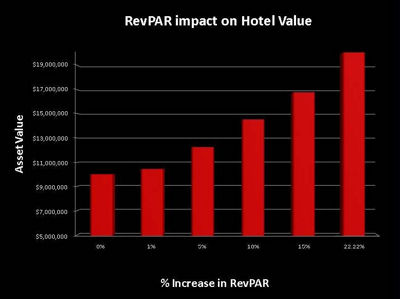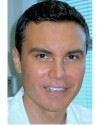 |
 |
|
News for the Hospitality Executive |
 |
 |
|
By Jean
Francois Mourier
April 27, 2010 We're going to change things up a bit today and write directly to all the hotel owners out there. So all you GM and revenue managers- or all of you that don't want to own the place someday- go ahead and put this down, or minimize this window. Oh, everyone's still here? OK, let's get to it then. We want to talk about RevPAR (no surprise there), but specifically how it pertains to the capitalization rate of the property. Everyone knows how important RevPAR is to cash flow, and to the net income of the operation, but too often RevPAR's inextricable link to cap rate is overlooked. And this is unfortunate, because in hotels, even moderate increases in RevPAR can translate into spectacular increases in cap rate; if we take for example a 10% increase in RevPAR at a $50 million in revenue hotel can yield a 50% gain in cap rate or more. An asset- like the real estate and the physical plant of a hotel- is valued based on not only its natural appreciation, but also on the revenue it produces on an annual basis. The basic measure of this revenue production to the original price the asset was purchased at, is its cap rate. Capitalization rate, in specific terms, is defined as the ratio between the net operating income produced or earnings before interest and taxes (EBIT) typically by an asset and its capital cost (the original price paid to buy the asset). The current market value of the asset can also be used as an alternate computation of cap rate. Because of the net operating income aspect of the metric, cap rate often doesn't figure into the valuation of less dynamic assets, but for hotels it figures quite prominently. And increasing RevPAR is the most direct way to increase cap rate. On the surface, this is common sense. After all, hotels are developed on a given piece of real estate in order to establish a reliable revenue stream- more reliable than that generated by residential or retail units (something we all learned playing Monopoly). The link between the revenue generated by the property itself and RevPAR is easily understood as well. But the connection between RevPAR and cap rate does not seem to receive as much emphasis as other financial measures. The fact is, an increase in RevPAR directly correlates to an increase in equity and the value of the property. This correlation is based in the outsized influence RevPAR has on a hotel's net operating income; because of the negligible cost of goods sold associated with room sales, and because room sales can represent as much as 90% of total revenues for a hotel, revenue generated per available room is the single most important contributing factor to a hotel property's net operating income or profit nlike F&B. To put that into real dollar figures, consider a 300-room hotel with $7.5 million in annual revenue and $1 million in annual profits. This property, originally valued at $10 million, has a cap rate of 10%, which implies the hotel has a RevPAR of $68.49. The next year, this hotel institutes a program that increases RevPAR by 5% (an increase that is legitimately attainable through the use of a sophisticated revenue management program), which in turn increases annual revenues to $7.875 million. Let's assume this hotel runs with a typical variable average room costs and converts every incremental $1 into $0.6 of profit or a 60% conversion of increased revenue into profits. If you were to increase ADR by 5%, your variable cost increase would be minimal and your increase would almost convert into profit at 100%. This increase will correspond to a bump in annual profits of around $225,000 (375,000 x 60%=225,000). The profit for the property this year goes up by 22.5% to $1.225 million; in other words, the 5% increase in RevPAR translates to a 22.5% increase in profits which, at a 10% cap rate, increases the hotel value to $12.25 million! A general rule is that every 10% increase in RevPAR translates into a 45% gain in the value of the hotel and its profits.  To achieve high cap rates, then, it stands to reason that maximization of RevPAR should be priority number one for owners and their agents in hotel operations (GMs). With all of the demands placed on owners of hotel properties, it may be easy to lose sight of this particular aim, but if the overarching goal is to increase the value of your property, then the savvy owner will hone in on RevPAR with intensity. But if RevPAR is the key to high and positive cap rates, then how should owners and their agents go about maximizing it? Entire textbooks have been written about ways to increase RevPAR- that subject is also often the focus of our articles- and as every hotel property is different, different RevPAR optimization solutions can and should be utilized. We believe that because RevPAR is closely related to both occupancy percentage and average daily rate, then the optimization of room rates (through real time, demand-based rate modification) coupled with vigilant inventory and sales channel management is the best way to increase RevPAR. Furthermore, we believe that this rate optimization/revenue management process becomes more cost-effective (and more effective, period) through automation, and with the help of a comprehensive system that can perform all of these functions accurately. To be clear, the functions that most influence RevPAR are yield management, channel management, competitive pricing, inventory control, rate optimization, GDS distribution, booking pace, and page positioning on third-party websites (like OTAs). With the proper system in place, a hotel has a better chance of increasing RevPAR over both the short and long term. With higher RevPAR, a property's cap rate will increase, driving the overall value of a property much higher as well. And that's something that ought to make all the owners out there very happy indeed.  Jean Francois Mourier is CEO &
Founder of RevPar Guru, a
company that has developed an alternative type of revenue management
and real-time pricing solution (combined with automated online
distribution) to help hotels maximize occupancy and increase their
profits. The company’s Yield Dynamic Price Engine, an integrated
revenue management and pricing solution, adds unprecedented power and
real-time adaptability to the pricing process, leaving managers more
time to run their hotels. You may reach him through www.revparguru.com or by calling
+1.786.478.3500. Jean Francois Mourier is CEO &
Founder of RevPar Guru, a
company that has developed an alternative type of revenue management
and real-time pricing solution (combined with automated online
distribution) to help hotels maximize occupancy and increase their
profits. The company’s Yield Dynamic Price Engine, an integrated
revenue management and pricing solution, adds unprecedented power and
real-time adaptability to the pricing process, leaving managers more
time to run their hotels. You may reach him through www.revparguru.com or by calling
+1.786.478.3500.
|
| Contact:
REVPAR GURU INC.
|